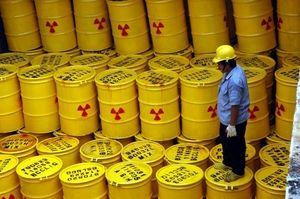Nuclear wasteSafety of nuclear waste storage questioned
The aftermath of the Hiroshima and Nagasaki bombings, and the Chernobyl accident, offers proof that high doses of radiation can have pernicious effects on plant and animal life. The largest human-made radiation risk, however, lies in nuclear waste stored near reactors or in underground repositories like the Waste Isolation Pilot Plant(WIPP) in Carlsbad, New Mexico.

Safety of nuclear waste questioned again // Source: secretchina.com
The aftermath of the Hiroshima and Nagasaki bombings, and the Chernobyl accident, offers proof that high doses of radiation can have pernicious effects on plant and animal life. The largest human-made radiation risk, however, lies in nuclear waste stored near reactors or in underground repositories like the Waste Isolation Pilot Plant (WIPP) in Carlsbad, New Mexico. The WIPP’s February 2014 plutonium radiation leak contaminated twenty-one workers and has led both supporters and critics of nuclear power to question the safety of nuclear waste storage. In the February leak, exhaust systems automatically forced the radioactive plume through High Efficiency Particulate Air (HEPA) filters to contain it, but small amounts of radiation did escape.
Gary Lanthrum, principal engineer for Radioactive Material Transportation and Storage Consulting, said “safety is a charged term.” He assures that radiation risk is lower than other industrial risks due in part to the numerous regulations placed on radioactive materials.
Transuranic wastes like plutonium and americium deposited at WIPP ship in Type B containers that can withstand eighty miles per hour locomotive impacts without leakage. Outside Online notes that these isotopes emit low-energy radiation, but since they have long half-lives (plutonium-239 takes 24,000 years to halve its radioactivity), they require highly secured permanent storage. Deep underground storage has been scientists’ preferred method of storing radiation waste. The storage rooms at WIPP are 2,150 feet deep surrounded by two-million-year-old salt deposits. Over time, the salt encapsulates the waste, “virtually entombing it for eons,” says Russell Hardy, director of the Carlsbad Environmental Monitoring and Research Center.
The more serious safety risk is high-level radioactive waste which emits intense gamma particles, strong enough to penetrate lead. About 270,000 metric tons of such waste are temporarily stored. “Right now we have no disposal program for the spent nuclear fuel from power plants, and all of it is just sitting on the surface,” Lanthrum says.
The waste is kept in open steel-lined concrete pools. Greg Mello, executive director of the Los Alamos Study Group, prefers dry casks lined with thick steel and concrete. Under both storage methods, the radiation level of stored waste drastically decreases after five years, but to how much of the radiation are humans exposed?
The average American receives an annual radiation dose of 600 millirems from sources such as the Earth’s natural radon gas or cosmic radiation that penetrates the atmosphere. Workers at WIPP are allowed exposure to 5,000 millirems per year, but even the twenty-one workers exposed to February’s leak absorbed only 100 millirems. Residents in close proximity to the WIPP likely received one millirem, a dose equivalent to eating ten bananas, which contain radioactive potassium.
A wide-spread radiation disaster is unlikely, but nuclear waste represents a high risk that can be exacerbated by human error. “Imagine a matrix of possibilities consisting of types of waste arrayed along one axis and various situations along another axis with a third dimension of time,” says Mello. “Some of the cells in that table will be pretty darn safe, some will be safer than alternatives, some will be Iffy, and some will be pretty bad ideas.”
